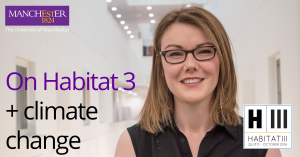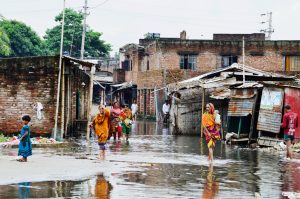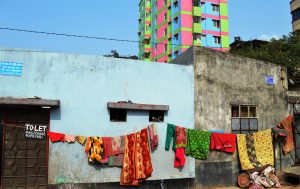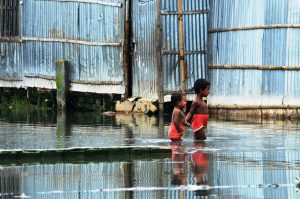By Joanne Jordan, Lecturer in Climate Change & Development at the Global Development Institute 
This month more than 25, 000 delegates meet in Quito, Ecuador, for the Habitat 3 conference which sets out the United Nations’ New Urban Agenda – a guide to policies and approaches for the sustainable development and planning of cities and towns across the globe for the next 20 years.
As part of The University of Manchester’s research beacon for Addressing Global Inequalities, we bring you a special series of blogs from some of our leading researchers. Here, Joanne Jordan talks about the importance of capturing local voices and ideas, if the UN’s New Urban Agenda and Habitat 3 visions for sustainable cities is to be realised.
Bold statements
Under Point 13G of the New Urban Agenda sits a very bold statement: “We envisage cities that adopt and implement disaster risk reduction and management, reduce vulnerability, build resilience and responsiveness to natural and man-made hazards, and foster mitigation and adaptation to climate change.”
 This is an important aspiration and one close to my heart, experiences and research in Dhaka – the capital of Bangladesh and a place on the front line of climate change. As part of my research on climate change at the University of Manchester’s Global Development Institute, I spent months in a slum in Dhaka talking to over 600 people in their homes, work places, local teashops and on street corners to understand how climate change affects their ‘everyday’ lives and what solutions they employ.
This is an important aspiration and one close to my heart, experiences and research in Dhaka – the capital of Bangladesh and a place on the front line of climate change. As part of my research on climate change at the University of Manchester’s Global Development Institute, I spent months in a slum in Dhaka talking to over 600 people in their homes, work places, local teashops and on street corners to understand how climate change affects their ‘everyday’ lives and what solutions they employ.
So what might the New Urban Agenda mean to the people living in Dhaka’s slums? Currently, most mainstream work on reducing inequality doesn’t take into account the different risks that people face as a result of climate change and this means that the interventions aimed at reducing inequality are likely to be less effective.
Most people who are adversely affected by climate change are already poor and are likely to become poorer as a result of it. Inequality affects how people respond to climate change. My research looks at how those responses differ and why. This can point to what kinds of interventions will help even out the playing field.
Innovation and land right issues
My research found that the urban poor have been able to develop a myriad of innovative ways to respond to climate change but in many cases their efforts are constrained by a lack of land tenure rights. For example, if slum dwellers are not protected by laws and regulations that shield them from exploitative landlords, they are less likely to invest scarce resources in making their homes more resilient to climate change.
Limited resources can also trap the poor in places that flood most frequently because they cannot afford rents elsewhere. One slum dweller explained: ‘The water came up to my waist, our houses drown. Where can we go? The more water, the less the rent. The rent is low here. The owner is going to raise the land, but the rent will go up. This will not help me. We will move somewhere else. We are poor, wherever we can get cheap rent, we move there.’
Broadcasting local voices
Throughout my time as a researcher, I have been a firm advocate of innovative approaches that capture and share the voices of local people.
So once my research in Dhaka was complete, I teamed up with the Department of Theatre and Performance Studies at the University of Dhaka to explore the findings through a ‘Pot Gan’ – a traditional folk medium that combines melody, drama, pictures and dancing.
The Pot Gan we developed was an interactive event that challenged the audience to engage with the personal experiences of slum dwellers affected by climate change.
Live performances of ‘The Lived Experience of Climate Change: A Story of One Piece of Land in Dhaka’ have now been seen live by over 600 people, including Dhaka slum dwellers, policy makers, practitioners, academics and the general public. At the time of publishing this blog, a documentary on the Pot Gan has been viewed by over 50,000 people.
 The New Urban Agenda: time to engage?
The New Urban Agenda: time to engage?
If you look at any given intervention, its success depends on whether it fits with people’s everyday experiences and understanding of climate change. Therefore, to create effective climate resilience strategies, it is crucial that we engage local voices in innovative ways to ensure that we do not leave the disadvantaged and most vulnerable behind by predefining their ‘problems’ and bypassing their priorities and realities. My project provided a platform for the ‘voices of the urban poor’ to enter the climate change debate – challenging us to inclusive action and critical thought.
And this mirrors my hopes and advice to those driving forward Habitat 3’s New Urban Agenda. I say: do not forget to engage the very people you strive to help. As you roll out the agenda over the next 20 years, consider approaches that may be new or different for you – as Pot Gan was for me – but which give a voice and a greater understanding of the changes you seek to bring about by putting the power in the hands of the very people who are finding ways every day to “reduce vulnerability, build resilience and responsiveness.”
Whilst the New Urban Agenda must operate at a national and strategic level to bring about a greater good, let it not forget about engaging and projecting the voices and ideas of the local people it aims to serve.
A documentary and video of the Pot Gan performance is available at https://bit.ly/GDIpotgan

Trackbacks/Pingbacks